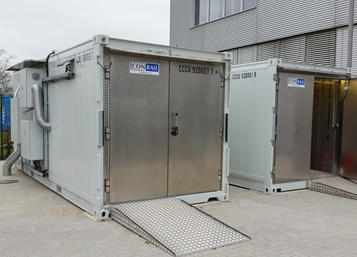
Introduction to Storage Options
Climate-Controlled vs. Standard Storage – Whether you are moving, downsizing, or need to clear some clutter, choosing the right storage solution impacts the long-term condition of your belongings. Standard storage and climate-controlled storage are two popular alternatives, both offering secure space yet differing fundamentally in environmental protection. Familiarity with these distinctions can help minimise costs, safeguard valuables, and provide lasting peace of mind.
What Is Climate-Controlled Storage?
Climate controlled storage facilities regulate both temperature and humidity. This environmental moderation is crucial for items that could be compromised by temperature fluctuations or moisture, making such units the optimal choice for belongings that need unvarying atmospheric conditions.
Temperature and Humidity Regulation
Typical climate-controlled units are maintained within a temperature range of 55°F to 85°F and control humidity to levels that avoid excess moisture or dryness. This environment inhibits warping of wood, rust on metal, the formation of mould, and the cracking of finishes or materials.
Ideal Conditions for Sensitive Items
The stabilised conditions afforded by climate control suit a variety of sensitive possessions, including antiques, precision electronics, original artwork, musical instruments, government and financial archives, and upholstered furnishings. With these safeguards in place, items remain in their original, undamaged state, reducing the likelihood of irreversible deterioration.
What Standard Storage Offers
Standard storage facilities are usually outdoor or non-insulated indoor compartments that provide minimal cover against rain and direct sunlight without regulating temperature or humidity.
How Standard Units Function
Functionally resembling a locked garage, these compartments deter theft and shield belongings from inclement weather, while still permitting seasonal temperature variations to penetrate the stored contents.
Common Applications for Standard Storage
Standard compartments work well for robust possessions, including outdoor tools, patio furniture, vehicles, and non-sensitive household items.
Seven Advantages of Climate-Controlled Storage
1. Regulated Temperature Exposure
Broad temperature swings can alter the dimensions of wood, leather, and plastics, resulting in splitting or distortion.
2. Moisture and Mould Mitigation
Controlled humidity thwarts mould, mildew, and corrosion, serving as a basic safeguard for prolonged storage.
3. Electronics Preservation
A stable temperature environment sustains circuit board integrity, curbing corrosion and potential hardware malfunction.
4. Safeguarding Antiques and Furniture
Climate control helps conserve wood finishes, textile integrity, and the condition of metal hardware in delicate, valuable items.
5. Sustained Long-Term Quality
Stored belongings retain their nearly original condition even after an extended duration in the unit.
6. Improved Air Quality for Contents
Filtered, circulating air diminishes dust accumulation on stored possessions.
7. Secure for Seasonal Inventory
Retailers can store seasonal merchandise without risk of damage, streamlining inventory turnover between high and low seasons.
When to Select Climate-Controlled Storage Instead of Standard
Storage During Severe Seasonal Conditions
In areas subject to oppressive summer heat or harsh winter cold, climate-controlled spaces mitigate risks of heat deformation or moisture-related damage.
High-Value or Sentimentally Charged Items
For anything that is either costly or irreplaceable, investing in climate control becomes a prudent choice.
Business Inventory, Documents, or Electronics
Paper records, sensitive electronics, and seasonal merchandise maintain structural integrity and longevity in a stabilised environment.
Cost Comparison: Climate-controlled storage vs standard storage
Typical Pricing for Each Category
Climate controlled storage units typically run 20 to 50 per cent above the cost of traditional spaces. A standard 10×10 size may be priced around $100 in a conventional arrangement, while a climate-controlled counterpart may be $150.
Assessing Value Relative to Expense
The premium spent is often recouped manifold in reduced repair bills or avoidance of replacement runs, making the investment financially rational in many situations.
Pros and Cons of Each Storage Type
Climate-Controlled Storage Pros and Cons
Pros:
- Safeguards delicate possessions
- Reduces the risk of mold and corrosion
- Best for extended storage periods
Cons:
- Higher pricing
- Fewer options in rural regions
Standard Storage Pros and Cons
Pros:
- More affordable
- Easily accessible
- Meets needs of resilient possessions
Cons:
- Absence of climate controls
- Unsuitable for valuables and delicate items
How to Select the Right Storage Option
Assessing Item Requirements
Examine the material composition, monetary worth, and sentimental value of your items.
Geographic and Access Considerations
Climate control is crucial where winters freeze and summers overheat.
Financial and Duration Considerations
Weigh storage fees against the potential for loss or repair expense.
Tips for Maximising Storage Investment
Preparing Items for Storage
Thoroughly clean, dry, and protect items in boxes or wrapping.
Insurance and Facility Security
Choose sites with cameras, sturdy locks, and policy options.
FAQs
1. Are climate-controlled units justified by the price?
Yes, if your items are delicate, expensive, or prone to moisture damage.
2. Which possessions do not require climate control?
Common tools, camping gear, and rugged furniture tolerate standard units.
3. May I store electronics in standard storage?
Not advisable because of the risk of overheating and humidity.
4. How long can items remain in climate-controlled storage?
There is no practical limit, given that rental fees are kept current and the items are properly packaged.
5. Do climate-controlled units incorporate air conditioning?
Yes, the units are equipped with HVAC systems that manage both temperature and relative humidity.
6. Are climate-controlled units confined to indoor locations?
Most such units are found indoors, but some outdoor facilities provide insulated containers equipped with temperature and humidity control.
Conclusion
The decision to select climate-controlled storage versus traditional storage revolves around the specific requirements of the items, the geographical context, and the overall financial plan. While climate-controlled units command a premium price, they deliver superior safeguarding for sensitive, high-value possessions. Standard environments protect typical, durable items well. The final determination, therefore, should seek equilibrium between expenditure and the necessary level of care.
If you’re looking for reliable and secure storage, then Conrail offers both climate-controlled and standard units, so you can easily choose the option that best suits your needs. Visit Conrail to explore available options.
